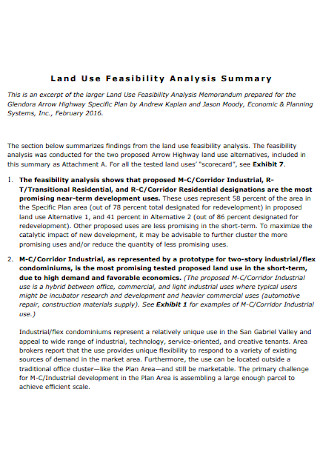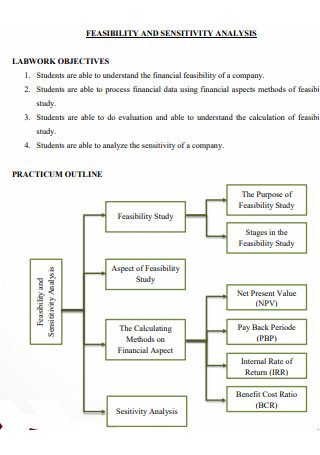25+ Sample Feasibility Analysis
-

Against Feasibility Analysis
download now -

Feasibility and Cost-Benefit Analysis
download now -

Initial Feasibility Analysis
download now -

Full Feasibility Analysis Template
download now -

Feasibility Analysis Format
download now -

Feasibility Analysis Plan
download now -

New Venture Feasibility Analysis
download now -

Work Feasibility Analysis
download now -

Simple Feasibility Analysis
download now -

University Feasibility Analysis
download now -

Due Diligence and Feasibility Studies
download now -

Land Use Feasibility Analysis
download now -

Technical Feasinbility Analysis
download now -

Techno-Economic Feasibility Analysis
download now -

Financial Feasibility Analysis
download now -

Feasibility Analysis of Sustainable Construction
download now -

Deasibility Analysis of Power Plant
download now -

Project Feasibility Analysis
download now -

Architecture Feasibility Analysis
download now -

Feasibility Analysis of Medium Enterprises
download now -

Case Studies in Feasibility Analysis
download now -

Feasibility Studies Analysis
download now -

Sample Project Feasibility Analysis
download now -

Feasibility Analysis Agreement
download now -

Feasibility amd Sensitivity Analysis
download now -

Economic Feasibility Analysis
download now
FREE Feasibility Analysis s to Download
25+ Sample Feasibility Analysis
What is a feasibility analysis?
Kinds of Feasibility Analysis
How to Conduct a Feasibility Analysis
FAQ
If there has to be two major characteristics of a feasibility analysis, what would they be?
What are other examples of legal feasibility?
How do I make sure my feasibility study is well structured?
What is a feasibility analysis?
Feasibility analysis, or most times referred to as feasibility study, is pretty self-explanatory. Its whole purpose is to gauge the possibility of success of a certain project, or if it is anywhere near doable with respect to the original target of its facilitators. This ensures that an objective is legally and technically viable, and that it actually has a promising return of investment. Whether the project is a study or a business, these things cost a lot of money to begin with, hence it is very important to know during the primary stages if they give out satisfactory results, or work like how it is supposed to. Aside from that, feasibility analyses just make an entire project more organized during execution, thus making it an integral part in the process of conceiving it.
Kinds of Feasibility Analysis
Feasibility analyses do not target vague ideas picked out from the project, otherwise it is not able to serve its purpose. Specificity is an important characteristic you can identify from a good feasibility analysis, because it elaborates the intended focus of the study or business model. Because its nature lies on measuring a certain project’s capability for success, it is important for you to note of the different kinds of feasibility analysis in order to know what your project specifically needs by virtue of the concerns of the project in and of itself. However, when it comes to studies, it should be taken note of that you may need to have more than one kind of feasibility analysis in order for your project to be catered to as a whole instead of in certain parts only. This is due to the complexity of various studies, and researchers may have to target more than one aspect of the topic they chose.
How to Conduct a Feasibility Analysis
Step 1: Outlining the Plan
Assuming that the project and target problem are already thought of, you may begin your analysis through making an outline of all the important points that you aim to hit. If you are conducting a study, you may create your outline through identifying the nature of your project, which means a brief description of it will do. After that, talk about your target market and how you expect them to react to your project, and why they are likely to do so. Next, discuss your marketing strategy precisely and why you think it is the best strategy for your product, as well as why you think it makes you one step ahead of others. The kind of feasibility analysis may be discussed subsequent to the aforementioned, as well as the meta analysis of which i.e. why this aspect, or these aspects, are crucial to have as lenses to be looked at for the project.
Step 2: Income Statement
Even if you are not necessarily making an economic feasibility analysis exclusively, it is still important for you to give an income statement. This allows you to view your project backwards, which means in here, you are able to state how much you need in order to commence the widespread of your project, or perhaps both your expected income and spending for it. It is important for you not to speak in absolutes when making an income statement, as allowances may be needed in case of later adjustments of your project.
Step 3: Organization and Operations
To get your project the recognition it deserves, the organization of the committee needed for it to commence is important to talk about. In here, you may also talk about the venue you are most likely going to present your product, or where you are going to test it. Through this, you may gauge the needed equipment and personnel for your project.
Step 4: Review and Analyze Data
Your claims are not superficial and ambiguous, since a lot may be affected by the things you claim there to be the accurate background of your problems, or the sample group you are targeting, and the like. Because heavy research and a plethora of references as well as projections are done, it is likely that you might have missed something, or misinterpreted a few things. Reviewing and reanalyzing the gathered data is always an important step in making sure that your project is intact and accurate, more so the analysis of its possibility for success. All in all, this is the step that concludes your feasibility analysis that gives you the assurance that you have triumphantly assessed the important aspects of your project.
FAQ
If there has to be two major characteristics of a feasibility analysis, what would they be?
They would have to be thorough and unbiased. Because it is an analysis, it has to be elaborate, clear, and specific. Vagueness has no place in making a good run-through on the given important aspects. Moreover, it is important for the analysis to be unbiased, and it should not be bent to favor the optics of your project. At the end of the day, it is your project that will suffer if you are partial in assessing its possibility in the long run.
What are other examples of legal feasibility?
Legal feasibility, in a very general sense, is the legal and ethical conformity of your study, which is extremely essential. A few examples of which are business licenses, government certification, insurance, copyright, health and safety protocols, and tax number.
How do I make sure my feasibility study is well structured?
You may refer to precedence which can be downloaded through the samples in the top half of the article, or you may download a project managing application in order to check and balance the data that you are formulating. For optimal results, you may use both in order to have multiple references and safeguards.
A project needs a backbone to support it once it has to stand in order to be used by the greater society. Feasibility studies are very important because they are preemptive measures that allow us to assess different aspects of our projects to make sure that certain standards are met, or that we are actually investing time, effort, and money on something that is surely going to give us something back. Background assessments and further research truly is needed for this in order for us to be able to see the bigger picture, and draw insights based on supported ideas we can find from precedence.
